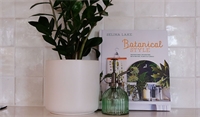Ikebana: The art of Japanese flower arrangement
It goes beyond simply placing flowers in a vase and focuses on creating a beautiful composition that reflects the beauty of nature and the changing seasons.
1: Gather Your Materials
Before you start, gather the necessary materials. You will need:
Flowers and Branches: Select a variety of flowers and branches with different shapes, sizes, and textures. Traditional Ikebana often uses seasonal flowers, but feel free to use what's available.
Container (vase): Choose a suitable container that complements the style of your arrangement. Ikebana Our Robert Gordon Flower Log is the perfect vessel to achieve this elegance in your own home. Check out these instructions and create your own Ikebana masterpiece. You can also use any vessel with a flower Frog (Kenzan): This is a metal or plastic pin holder that fits inside the vase and holds the stems in place.
Scissors or Pruners: Use sharp scissors or pruners to cut the flower stems cleanly.
Water: Fill a container with clean water to keep your flowers fresh.
2: Prepare the Flowers
Before you begin arranging, trim the flower stems at a sharp angle. Cutting at an angle allows the flowers to absorb more water and stay fresh longer. Remove any leaves that will be below the waterline, as they can promote bacterial growth and shorten the flower's lifespan.
3: Create a Basic Structure
Ikebana arrangements often use a kenzan (floral frog) to hold the stems. If using a floral log, fill the vessel and use the holes to insert your flower stems. If using a kenzan or flower frog, place it at the bottom of your vase and press it gently to secure it in place. The kenzan's spiky surface will act as an anchor for your flower stems.
4: Embrace Simplicity and Space
Ikebana values negative space as much as the flowers themselves. Leave enough space between the elements to create a sense of harmony and balance. Avoid overcrowding the arrangement and let each flower have its own place to shine.
5: Focus on Lines and Balance
Ikebana is about creating graceful lines that flow together harmoniously. Consider the lines and angles of each stem as you place them in the arrangement. Achieve a balance between the different elements to create a visually pleasing composition.
6: Represent Nature and the Seasons
Ikebana often tries to mimic the beauty of nature and reflect the changing seasons. Use flowers, branches, and leaves that are in-season to capture the essence of the time of year. Consider the colors, shapes, and textures that represent the current season.
7: Pay Attention to Proportions
The proportions of your Ikebana arrangement are crucial. Consider the height and width of the vase, as well as the size of the flowers, to ensure a balanced and aesthetically pleasing result.
9: Be Mindful and Patient
Ikebana is not just about arranging flowers; it is a meditative and mindful practice. Take your time to consider each element and how they interact with each other. Be patient and embrace the process of creating something beautiful.
10: Enjoy and Adapt
There are no strict rules in Ikebana. The most important aspect is to enjoy the process and experiment with different flowers, styles, and containers. Adapt the techniques to suit your taste and the available materials.
With these steps, you can begin your journey into the art of Ikebana and create stunning, harmonious flower arrangements that bring a touch of Japanese elegance to your space.
Related

Making your own DIY couch pillow covers is a fun and rewarding project allowing you to explore new s...
Read More

The kitchen is referred to as the heart of the home, a place for gathering with family and friends a...
Read More

Stovetop potpourri is a delightful and easy way to fill your home with inviting scents. It involves ...
Read More